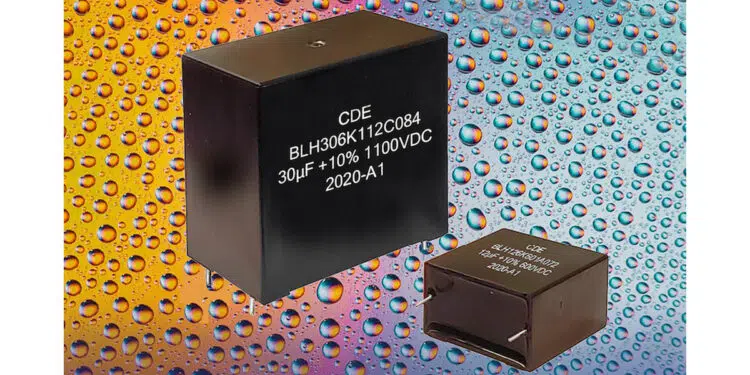Cornell Dubilier releases type BLH of film DC Link capacitors that exceeds industry standards for humidity testing, AEC-Q200 qualified.
Green energy and electric transportation systems have pushed explosive growth in inverter markets. Many of these applications present harsh operating environments for power electronics circuitry. Often, these applications demand a high percentage of uptime, increasing the need for highly reliable components. In response, CDE’s BLH series of DC-Link capacitors have been designed and tested to exceed the industry’s most stringent requirements for high humidity, vibration testing, and thermal cycling.
The Temperature, Humidity at Bias (THB) test exposes parts to the harsh conditions of 85 °C at 85% relative humidity with rated voltage applied. This demanding test simulates the harsh operating conditions encountered in many commercial and industrial inverter applications. Such conditions can cause non-THB rated capacitors to fail early from moisture penetration. While most capacitor makers validate their THB components for 1,000 hours under these conditions, CDE’s BLH series has been validated for 1,500 hours.
Utilizing the most advanced materials and processes, these board-mounted capacitors have been designed and tested to meet the rigors of automotive AEC-Q200 testing. Their solvent-resistant plastic case and epoxy encapsulation system are UL Recognized and meet IEC61071. Tin-plated copper RoHS-compliant terminations ensure excellent solderability. With their superior resistance to moisture and robust design, these capacitors are well suited for solar, wind, UPS, EV chargers, and other inverter applications that may be subjected to wide-ranging environmental conditions.
The series is optimized for DC link applications in medium to high-power inverters. Capacitance ranges from 1.0 to 170 µF at 450-1,200 Vdc, with high rms ripple current ratings up to 36 Arms. When operated at a 70 °C hot-spot temperature with rated voltage applied, their life expectancy is 100,000 hours.
• Optimized for inverter DC-Link Applications
• High capacitance
• High ripple current up to 36 Arms
• Self-healing and low loss
• THB 85 °C / 85 % RH, 1500h at rated voltage
• UL Listed
• AEC-Q200 Qualified
Applications Include:
DC Link for solar, EV, and other inverters that are subjected to the harshest environmental conditions, backup, UPS, portable power systems, motor drives, traction, and other transportation systems.































